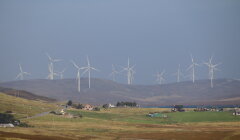Energy / Council’s energy development principles set in stone
COUNCILLORS have formally agreed a set of energy development principles – including for offshore wind projects around Shetland – which set out guidance on community benefit and environmental protection.
While the emergence of offshore wind was the prompt for the principles, they also cover other sectors such as wave, tidal and onshore renewables as well as oil and gas.
A report to councillors said Shetland partners were consulted with during the refinement of the principles, including the local fisherman’s association.
Draft principles were previously put to elected members earlier in the year, but the final version was approved at a meeting of the full council earlier today (Wednesday).
They cover topics like environmental protection, local supply chain opportunities and a fair local share of income from land and seabed rents.
The principles state: “Shetland recognises the future significance of offshore wind in global decarbonisation and is open to the potential to development of a successful offshore renewable energy industry in an environmentally responsible manner.
“However, we are equally determined that must be done in a balanced fashion, is aligned with just transition principles and that it has to deliver benefits locally as well as nationally.”
It says the SIC believes £5,000 per installed megawatt or 2.5 per cent of generation value is appropriate for community benefit for offshore wind, although further research may be taken to explore whether energy contributions could be another form of benefit.
The principles were largely welcomed by councillors, with depute convener Bryan Peterson saying it was “critical that we keep the public moving with us” on the issue – adding that many of those aggrieved with the Viking Energy onshore wind farm felt that way because they believed their voice was not heard.
Shetland Central member Moraig Lyall also stressed a desire for all elements of the principles to take equal priority.
Become a member of Shetland News
She hoped those who may have “pound signs” in their eyes regarding jobs and money would not forget about issues like environmental protection.
Three offshore wind sites to the east of Shetland are currently proposed, while developments in other areas may be in the pipeline too.
Meanwhile a commitment by three offshore wind developers to work more closely with stakeholders in Shetland has been welcomed locally.
Representatives of Ocean Winds, Mainstream Renewable Power (Mainstream) and ESB Asset Development visited Shetland last week.
All three are behind proposals, licensed through Crown Estate Scotland’s ScotWind process, to build offshore wind farms with a combined total capacity of 2.8GW to the east of Shetland.
If the £5,000 per megawatt community benefit scheme was applied then in theory these projects would tally up to a maximum of £14 million.
The combined site would be located around 12 miles east of Bressay.
The plans have drawn concern from Shetland Fishermen’s Association, particularly around the fleet being squeezed out of traditional grounds.
During last week’s visit the companies spoke to the industry, as well as Lerwick Port Authority and supply chain firms.
Ewan Walker, project director for Mainstream and Ocean Winds’ joint development, said: “Working with Shetland’s stakeholders and other offshore developers will be essential throughout the lifetime of this project.
“It will likely be at least a decade until the project is operational and we will work closely with the local supply chain to explore opportunities over the coming years as we progress the project.
“We are also committed to being a good neighbour to existing industries and, following a constructive initial meeting with commercial fishing representatives, we look forward to continued open engagement to mitigate potential impacts of our activities.”
Paul McElvanna, offshore wind project director at ESB, added: “We will work constructively with other marine users throughout the lifecycle of the project to minimise any potential disruption.”
Highlands and Islands Enterprise’s area manager for Shetland Katrina Wiseman added: “We also expect any developer to work closely with key industries such as fishing to mitigate any potential impacts. We are pleased to have obtained an early commitment to meet on a regular basis and start to build relationships.”
Wednesday’s meeting also heard from SIC infrastructure director John Smith that the challenge for offshore wind would be having “meaningful consultation” due to the distance from shore.
He said the ScotWind site is just outside the 12 nautical mile distance in which the council has local jurisdiction over in planning and works licences.
Smith explained that the principles are not to be used to rank proposed projects, but they are there to help people recognise the balance between opportunity and risk.
Meanwhile Shetland North member Tom Morton said he felt it was important that the council – as representatives of the community – should be involved in how any future community benefit is distributed.
Local Green councillor Alex Armitage highlighted that there is a “moral and legal responsibility” to fight climate change, and said offshore renewables will support energy security.
But Shetland South member Allison Duncan said he supported continue to explore the use of oil and gas resources, and only reduce this when appropriate in stages.
Lerwick South member Neil Pearson also said “we need to do everything we can” to prioritise affordable energy for islanders when it comes to future renewable developments.
Become a member of Shetland News
Shetland News is asking its readers to consider paying for membership to get additional perks:
- Removal of third-party ads;
- Bookmark posts to read later;
- Exclusive curated weekly newsletter;
- Hide membership messages;
- Comments open for discussion.
If you appreciate what we do and feel strongly about impartial local journalism, then please become a member of Shetland News by either making a single payment, or setting up a monthly, quarterly or yearly subscription.












































































